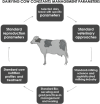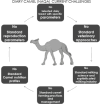History of a dairy camel (NAQA) and machine milking in Saudi Arabia; challenges and prospective
- PMID: 39448450
- PMCID: PMC11502539
- DOI: 10.1007/s11250-024-04211-8
History of a dairy camel (NAQA) and machine milking in Saudi Arabia; challenges and prospective
Abstract
Over the past two decades, there has been a noteworthy surge in the attention and interest surrounding camel rearing and camel milk production in Saudi Arabia. This focus has emanated from diverse stakeholders including the general public, camel breeders, and researchers. While limited quantities of camel pasteurized milk currently available in selected showrooms, the sale of raw milk near camel enclosures remains prevalent. Recent developments include the inauguration of a modernized, opulent showroom in Riyadh exclusively dedicated to showcasing camel milk and its derivatives. The commencement of machine camel milking trials in Saudi Arabia traces back to 2003 when a portable single-bucket cow milking machine was initially tested at the Al-Jouf Range and Camel Research Center in Sakaka city. Subsequently, a company in the northern region of Saudi Arabia emerged the nation's first semi-automatic camel milking line in 2008, which continues to operate to this day. However, these endeavors, while pioneering, lag behind contemporary milking technologies prevalent in dairy farms focused on cows. Despite these strides, there exists a notable dearth of comprehensive data encompassing critical aspects of dairy camel farming. Absence of information on dairy camel and total seasonal milk yields, scientific data on machine milkability, and established production standards and characteristics for female camel milk hinders the sector's progress. This review endeavors to elucidate the obstacles and challenges hindering the widespread adoption of camel machine milking and the implementation of good camel management practices. It also outlines prospective measures aimed at overcoming these challenges for a more robust future for camel as a productive livestock in Saudi Arabia. With global climate changes, crises of protein and water shortages worldwide, and the remarkable production potentials of camels, this exploration aims to contribute to the sustainable development of camel farming in the context of evolving global challenges and opportunities.
Keywords: Camel; Dairying; Machine milking; Management practices; Sustainability.
© 2024. The Author(s).
Conflict of interest statement
The authors declare that they have no competing interests.
Figures








Similar articles
-
Review of present knowledge on machine milking and intensive milk production in dromedary camels and future challenges.Trop Anim Health Prod. 2016 Jun;48(5):915-26. doi: 10.1007/s11250-016-1036-3. Epub 2016 Mar 18. Trop Anim Health Prod. 2016. PMID: 26992732 Review.
-
Effects of milking interval and cisternal udder evaluation in Tunisian Maghrebi dairy dromedaries (Camelus dromedarius L.).J Dairy Sci. 2009 Apr;92(4):1452-9. doi: 10.3168/jds.2008-1447. J Dairy Sci. 2009. PMID: 19307626
-
Dam-calf contact rearing in Switzerland: Aspects of management and milking.J Dairy Sci. 2024 Sep;107(9):7185-7200. doi: 10.3168/jds.2023-24424. Epub 2024 May 17. J Dairy Sci. 2024. PMID: 38762107
-
Sensors and management support in high-technology milking.J Anim Sci. 2003;81 Suppl 3:1-10. doi: 10.2527/2003.81suppl_31x. J Anim Sci. 2003. PMID: 15000401 Review.
-
The effect of concentrate supplementation on milk production and cow traffic in early and late lactation in a pasture-based automatic milking system.Animal. 2018 Apr;12(4):853-863. doi: 10.1017/S1751731117002221. Epub 2017 Sep 21. Animal. 2018. PMID: 28931455
Cited by
-
Risk Prevention and Quality Control in Camel Milk Collection: Insights from Field Research.Foods. 2025 Mar 21;14(7):1090. doi: 10.3390/foods14071090. Foods. 2025. PMID: 40238200 Free PMC article.
References
-
- Abdallah HR, Faye B (2012) Phenotypic classification of Saudi Arabian camel (Camelus dromedarius) by their body measurements Emirates. J Food Agric, 24
-
- Abshenas J, Vosough D, Molaee MM, Masoudifard M (2007) B-mode ultrasonography of the udder and teat in camel (Camelus dromedarius) (Journal of Veterinary Research), 28–31
-
- Al-Saiady MY, Mogawer HH, Faye B, Al-Mutairi SE, Bengoumi M, Musaad A, Gar-Elnaby A (2012) Some factors affecting dairy she-camel performance Emirates, 24 edn. Journal of Food and Agriculture
-
- Aljumaah RS, Samara EM, Ayadi M (2012) Influence of introducing machine milking on biothermal parameters of lactating camels (Camelus dromedarius) Italian. J Anim Sci, 11 (4), e73
Publication types
MeSH terms
Grants and funding
LinkOut - more resources
Full Text Sources
Miscellaneous

